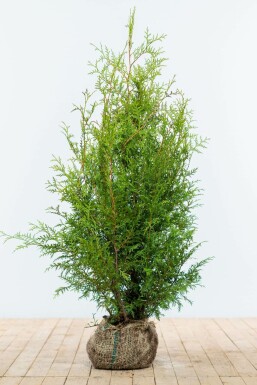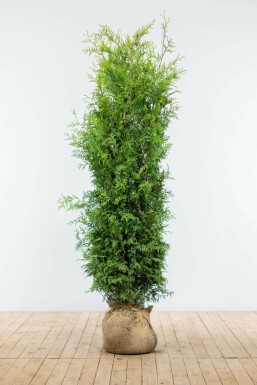Description
Thuja occidentalis 'Brabant' 180-200 cm | White cedar
The Thuja occidentalis 'Brabant', commonly known as white cedar, is a robust conifer that is highly prized for its hardiness and evergreen foliage. This cultivar of Thuja is well-suited for creating dense hedges that provide privacy and wind protection throughout the year. Its resilient nature and attractive greenery make it an excellent choice for both residential and commercial landscaping.
As a hedge or solitary plant, the 'Brabant' variety is a versatile addition to any garden. It maintains its vibrant green foliage across all seasons, ensuring a constant display of natural beauty.
Key Features
Several features distinguish the Thuja 'Brabant' as a superior landscaping plant:
- The 'Brabant' possesses a high winter hardiness, tolerating temperatures as low as -34.5°C up to -40.0°C, suitable for USDA zone 3.
- With a growth rate of 30 to 50 centimetres per year, it quickly forms a dense living wall, offering immediate visual density and privacy.
- The 'Brabant' is drought-resistant once established, making it a resilient species in various climate conditions.
- It thrives in all soil types, provided they are well-drained, and can be placed in sun, partial shade, or shade.
- Its evergreen foliage remains a consistent green throughout the year, adding a splash of colour even in the dreariest of winter months.
- The 'Brabant' does not flower, which means less maintenance and no concern for seasonal allergies typically associated with pollen.
Tips
For those considering the Thuja occidentalis 'Brabant' for their landscape, the following tips will ensure optimal growth and appearance:
- Prune twice annually to shape the hedge to your preference and encourage denser growth.
- Although 'Brabant' is drought-resistant, ensure young plants receive plenty of water until their root systems are fully established.
- When planting a hedge, space individuals properly to allow for their mature spread and ensure a seamless, bushy wall of green.
- If you wish to propagate your own 'Brabant' plants, take semi-ripe cuttings and plant them in a nurturing soil environment to grow new robust specimens.




































